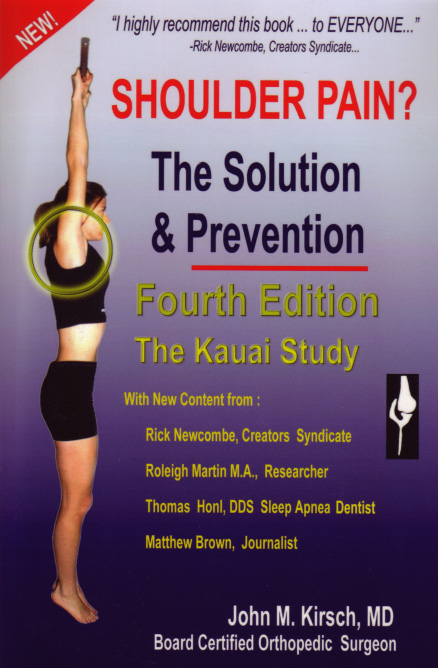Posts Tagged ‘kirsch shoulder prevention’
Hang like an Ape to save your shoulders
When it comes to the shoulder there are two main types of injury which interestingly represent the two extremes of shoulder function.
1. Dislocation
2. Impingement
Now impingement injury in our society is way more common than dislocation. How many people can you think of that dislocated a shoulder?
I can think of one only – my brother who did it having an epileptic fit. Maybe a couple of other people vaguely lurk in memory as having said they did it once.
Impingement on the other hand which includes bursitis, torn tendons, tendinitis and rotator cuff syndrome well I can think of over a dozen people very clearly and probably many more if I try and remember.
Why is this and what is the difference between the two injury types?
Well we are evolved from apes that love to swing from tree’s.

They dont just like doing it they love it.
And guess what – we have the same shoulder structure as an ape. Our shoulders are also designed to hang & swing.
Most of us, even athletes, however do not. Now little kids do it instinctively and some jobs require it. For example sailors in the age of sail used to hang, climb and swing all day. Tree pruners and fruit pickers do it.
But the jobs that involve this activity are limited.
When we do hangs and swings we are stretching & opening the shoulder joint. When we do other activities like back packing, weight vest training or overhead pressing we do the opposite. We compress the joint and its bones.
Neither extreme causes any problem until it is done to excess in an imbalanced manner.
What can happen then is the structure of the joint is altered adversely. Too much hanging and yanking and your shoulder joints acromium process will become too loose and open. This will increase probability of dislocation.
Too much back packing or pressing and the joint gets squashed down & the actual bone deforms and bends downward. This rubs on the tendons, which get worn and frayed then tear.
Its quite simple. The answer is to balance hanging with carrying. Do both in balance. If you have done too much of one, do the other for a while to readjust the joint structure.
For me I did very heavy weight vest marches and lots of super heavy kettlebell work for 5 years with very little bar work. I tore my rotator cuff as a consequence.

OK so thats the how and why of shoulder injury and as most of us do not climb ropes for a living but lift stuff or sit on our big fat ass – its impingement that is the most common injury of the shoulder.
If you have an injury or tear you will need to see your physio and go through the standard protocol of therapy while doing your best to avoid surgery. That is what I have done for six months and standard time for tendon repair is nine months but twelve is not uncommon.
So now I want full return to strength I came across the next stage of rehabilitation in this book:

The program is very simple but the book provides all of the evidence to back it up. Simply dead hang from your bar a dozen or so times per day.
After your hanging do very high rep very light dumbbell front, back & side raises all the way up to overhead.
Initially it hurts but as the joint opens the impingement & bursitis clear up and the pain subsides. There is no danger of tendon tear as the book illustrates but you had better be sufficiently advanced in your recovery.
There is no way in hell I could have done this a month or two back but I can now. Also the tendons may be safe in the hanging position but is actually getting into that position another story?
OK so this program is also a prevention for all crossfitters, kettlebell trainers and backpackers.
Do your time on the bar. Hang, its not the same as pull ups – hang. The other bar work is a bonus.
Another good thing is actual brachiation, swinging from bar to bar – thats what your shoulder evolved to do.